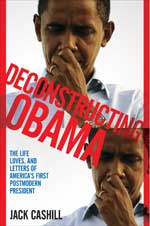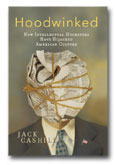What the Mailman Knows About Ayers and Obama
Get your copy of Deconstructing Obama

___
Jack Cashill's book:
Hoodwinked: How Intellectual Hucksters have Hijacked American Culture

Click here for signed first edition
©Jack Cashill
AmericanThinker.com - March 19, 2012
A few days ago I got a call asking whether I knew anything about the Ayers family mailman. I had heard of him, I said. I remembered liberal blogger Steven Diamond having interviewed the fellow a few years back but paid it little mind as the information seemed too limited to pursue.
The caller then sent me a video interview with the mailman by WND sleuth Jerome Corsi. The video made me sit up and pay attention. The mailman is a real person. His name is Alan Hulton. He seems entirely credible, and he has a story to tell.
Hulton delivered mail in Glen Ellyn, Illinois, from 1962 to 2001 with a couple years off to serve in the military. During roughly ten of those years he delivered mail to the home of Tom and Mary Ayers, Bill Ayers’s parents. Hulton talked to Tom once, Mary several times, their daughter-in-law Bernardine Dohrn a few times, and Bill Ayers not at all. Memorably, he talked once to one of their visitors, but more on that in a moment.
As Hulton tells Corsi—and he has sworn an affidavit to the same—he met Tom Ayers not long after the Ayers moved to the neighborhood. Until he retired in 1980 at the age of 65, Tom Ayers was the CEO and chairman of Commonwealth Edison. Tom, however, was not your garden-variety plutocrat. According to Diamond, who knows his way around Chicago politics, he was a “lifelong liberal,” one who was deeply involved in the same educational reform movement that engaged son Bill and, briefly, Barack Obama in 1988. Tom Ayers was comfortable enough with Bill’s lifestyle to live with him in Hyde Park until he died in 2007.
 When Hulton met Tom Ayers they talked about working conditions at the Post Office. “I couldn’t believe how he responded,” Hulton told Diamond. “He started to talk about workers having to struggle to survive and about peasants and the proletariat. It made me think later that he might be a Marxist!” Hulton would tell Corsi, “I had this uncomfortable feeling that he thought he knew about my situation as a working person better than I did, that he knew what was best for me.”
When Hulton met Tom Ayers they talked about working conditions at the Post Office. “I couldn’t believe how he responded,” Hulton told Diamond. “He started to talk about workers having to struggle to survive and about peasants and the proletariat. It made me think later that he might be a Marxist!” Hulton would tell Corsi, “I had this uncomfortable feeling that he thought he knew about my situation as a working person better than I did, that he knew what was best for me.”
Hulton also recalls one particular conversation with Mary Ayers. “She was enthusiastically talking to me about this young black student that they were helping out,” he tells Corsi, “and she referred to him as a foreign student.” Adds Hulton, “I was taken back by how enthusiastic she was about him.” Within a year of this conversation, Hulton had a fateful meeting with the young man he presumed Mary was talking about it.
According to Hulton, he encountered the fellow on the sidewalk on the front of the Ayers home. In that it was extremely rare to see a black man in this tony neighborhood, Hulton believes the man felt the need to explain his visit to the Ayers household. Hulton describes him as friendly and neatly, although casually, dressed. Hulton tells Corsi, “I am absolutely positive that it was Barack Obama.”
Hulton was sympathetic. After he had come out of military service, he was a supporter of Martin Luther King, who had pressed for fair housing in the Chicago area in the 1960s. “I took some flak about my support for civil rights from my fellow workers at the time,” remembers Hulton.
Obama explained to Hulton that he had taken the train out from Chicago to Glen Ellyn in order “to thank the Ayers family personally for helping him with his education.” What shocked Hulton was that when casually inquiring into the young man’s plans for the future, Obama answered, “I am going to be president of the United States.” As Hulton tells Corsi, “It came across like this was something that’s already been determined.” Adds Hulton, “I was speechless.”
Hulton told Diamond and Corsi essentially the same story. What gives the Corsi interview added value is that we see Hulton tell it. Although just a year older than Bill Ayers, he seems to come from a different generation. He has little to gain—and a lot to risk—by going public. Corsi warns Hulton that by quoting Mary’s comment that Obama was a “foreign student,” he put himself at some risk. Says Hulton, “I am only telling you what I distinctly remember her saying—that he was a foreign student.”
Hulton’s interviews with Diamond and Corsi are consistent in every major detail save for dates. Hulton suggested to Diamond that the sidewalk meeting took place in the mid-80s, but Corsi suggests to Hulton that it was in the early 1990s, and Hulton does not correct him. Hulton clearly does not remember the date. If I were to speculate, I would guess 1988, the year Obama started Harvard Law School. Presuming Hulton actually met Obama, the “education” in question would almost surely had to have been law school.
There is a good deal at stake here. According to Snopes and the other fact check sites, Bill Ayers and Obama did not meet until the mid-1990s. This is a talking point that both Ayers and Obama have upheld. When Ayers appeared on ABC’s Good Morning America in 2008, he put the date of their first meeting in 1995 at a fundraiser in Ayers’s own home. “I think he was probably in 20 homes that day as far as I know,” said Ayers. “But that was the first time I really met him.”
As it happens, I stumbled into my own discovery of Ayers’s involvement in the writing of Obama’s 1995 memoir, Dreams from My Father, when I was investigating how Obama got into Harvard Law School and who paid his way. What had piqued my interest was an interview with veteran New York power broker Percy Sutton on a local New York City show called "Inside City Hall." The interview took place in late March 2008 but did not surface until August 2008.
Sutton told how twenty years prior he had been “introduced to [Obama] by a friend.” The friend's name was Dr. Khalid al-Mansour, "the principal adviser to one of the world's richest men." The billionaire in question was Saudi prince Al-Waleed bin Talal. According to Sutton, al-Mansour had asked him to "please write a letter in support of [Obama] ... a young man that has applied to Harvard." Sutton had friends at Harvard and gladly did so.
A few months before the election it should have mattered that a respected black political figure like Sutton had publicly announced that a fanatic black separatist, backed by an ambitious Saudi billionaire, had been guiding Obama’s career perhaps for the last twenty years. It did to the Obama-friendly media, but not in a way it would have to real journalists. Moving in swiftly to kill the story were Politico, an insider DC journal run by Washington Post alums, and Media Matters for America, an alleged watchdog group founded by the recovering Troopergate author, David Brock.
Ben Smith of Politico took the lead. Shortly after the story broke, Smith ran the disclaimer that "Barack Obama's campaign is flatly denying a story told by former Manhattan Borough President Percy Sutton.” After some conspicuous waffling, al Mansour denied the story as well. A self-appointed “spokesman for Sutton’s family” by the name of Kevin Wardally sent an email to Smith that read in part: “As best as our family and the Chairman's closest friends can tell, Mr. Sutton, now 86 years of age, misspoke in describing certain details and events in that television interview.”
For Smith, even though Wardally had gotten Sutton’s age wrong by two years, this email was proof enough that Sutton’s highly specific claim was manufactured. Wrote Smith, Wardally’s email “seems to put the story to rest for good.” Media Matters meanwhile scolded those conservative bloggers that did not accept the various denials at face value.
Like the man about to be carted away in Monty Python’s Holy Grail, the Percy Sutton story was not quite dead yet. Sutton’s son and daughter told conservative reporter, Ken Timmerman, that no one in their family even knew who Kevin Wardally was, let alone authorized him to speak on behalf of the family. “I’m getting better,” pled Monty Python’s nearly dead man. No he wasn’t. Nor was this story. With Hillary out of the race, no newsroom in America felt compelled to dig up dirt that could sully Obama.
About that time, I found a diary entry that caught my attention. Radical-turned-actor Peter Coyote entered it at the time of the 1996 Democratic National Convention in Chicago. Coyote wrote, “I inform Martha that I'm dragging her to the apartment of old friends, ex-Weathermen, Bernadine (sic) Dohrn and Bill Ayers, hosting a party for Senator Leahy. Perhaps Edward Said will be there."
Said had taught Obama at least one class at Columbia. I had earlier seen a photo taken during an Arab-American community dinner in Chicago in 1998 on the fiftieth anniversary of the Palestinian nakba, or disaster. The photo shows Obama sitting next to Said, seemingly engaged in an animated conversation at dinner. The intimacy surprised me. At the time of the photo, Obama was an obscure state senator while Said, according to the Nation, was "probably the best-known intellectual in the world" and star of that evening’s show. He would speak on this occasion, as the Los Angeles Times would later report, "against settlements, against Israeli apartheid."
All of this got me to wondering whether an Ayers-Obama-Said-al Mansour cabal had formed in the early 1980s back in New York City. If so, such a combine might have generated enough momentum to push Obama’s career along. To see if Obama and Ayers had crossed paths before Chicago, I ordered a copy of Bill Ayers’ 2001 memoir, Fugitive Days. It was then that I began to realize the depth of Ayers’s involvement in Obama’s rise to power.
Obama would have needed help to get into Harvard. Friendly biographer David Remnick tells us that Obama was an “unspectacular” student in his two years at Columbia and at every stop before that going back to grade school. A Northwestern University professor, John L. McKnight, although a friend of Obama’s and a fellow Alinskyite, reinforces the point, telling Remnick, “I don’t think [Obama] did too well in college.” As to Obama’s LSAT scores, Jimmy Hoffa’s body will be unearthed before those are.
How such an indifferent student got into a law school whose applicants’ LSAT scores typically track between 98 to 99 percentile and whose GPAs range between 3.80 and 4.00 is a subject the media have chosen not to explore. Nor have they asked how Obama paid for that education. Maybe, it is time they ask the mailman.
Webmaster's Note: Jack Cashill's Book-TV presentation of "Deconstructing Obama" can be viewed at http://www.c-spanvideo.org/program/298382-1
Editor's note: For a more complete account of this phenomenon, read Jack Cashill's amazing book, "Hoodwinked: How Intellectual Hucksters Have Hijacked American Culture.

